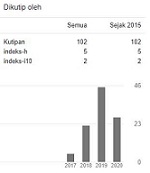STUDENTS’ DIFFICULTIES IN ENGLISH SPEAKING CLASS
Abstract
This study aim to answer: (1) What are of student’s difficulties and possible solution in English speaking at the ninth years grade of SMPI AL-KAROMAH SAMPANG? (2) What factors are causing student’s difficulties in English speaking at the ninth years grade of SMPI AL-KAROMAH SAMPANG?. The research design of this study is descriptive qualitative. The writer uses interview and observation as instrument of data. In this research, the researcher uses non participant observation, the writer only becomes an observer. The writer had taken part in class being observed. While participating as an observer, the writer observes what kinds of students’difficulties in English speaking and what are the causing factors students’ difficulties in English speaking. From the result of the observation, interview, and questionnaire the researcher concluded that most of the student at the ninth grade of SMPI Al-Karomah Sampang got difficulties in English speaking class here was caused by fear of mistakes, shyness, lack of motivation, and lack of confidence. And some of these factors are related to the learners themselves, the teaching strategies, the curriculum, and the environment.
Keywords
References
Al-Sibai, D. (2004). Promoting Oral Fluency of Second Language Learners: Educational Linguistics Department of English. King Saud University. Adult Learners of English.
Ali Saukah and Arwijati Wahyudi, English For the Senior High School Book 1, Jakarta: DsoEnemen Pendidikan dan Kebudayaan, 1996, hal v.
Aftat, Mokhtar, (2008), Motivation and Genuine learning. Available: http://www.englishteacher1.com/motivation.html (March 15, 2011)
Arsjad, Maidar G. dan Mukti U.S.1993. Pembinaan Bahasa Indonesia. Jakarta: Erlangga.
Baldwin, Caroline, (2011). How to Overcome Shyness During an Oral Presentation.Available:http://www.ehow.com/how_7852354_overcome-shyness-during-oral-presentation.html (February17, 2011)
Baker, Joana and Heater Westrup, 2005. Essential Speaking Skill. Britarian: Continuum
Effendi, S. 2007. Sikap Wajar Memandang Hari Depan Bahasa Indonesia. Jakarta: Pusat Bahasa.
Murcia, C and Olshtain, E. (2000). Discourse and context in language teaching: A guide for language teacher. Cambridge, England. Cambridge University Press.
Raba’ah, G. (2005). Communication Problems Facing Arab Learners of English. Journal of Language and Learning, 3(1), ISSN 1740-4983.
Ripkah. (2013). Teaching Strategis to Overcom Students’ Difficultiesin Learning Speaking. Madura University.
Sinaga, F. (2010). Peranan Bahasa Inggris Dalam Era Globalisasi diakses tanggal 20 Juli 2016.
Stanford, P. (2003). Multiple intelligence for every classroom. Intervention in school and clinic, 39(2), 80-85. Peranan Bahasa Inggris.
Tarigan, Djago.dkk. 1998. Pengembangan Keterampilan Berbicara. Jakarta:
Depdikbud Bagian Proyek Penataran Guru SLTP setara D III.
Tarigan, D. (2008). Berbicara sebagi Suatu Keterampilan Berbahasa. Bandung: Angkasa.
Thornbury, S. (2005). How to Teach Speaking. Essex: Pearson Education Limited.
DOI: 10.53712/ellite.v3i1.908
Refbacks
- There are currently no refbacks.







